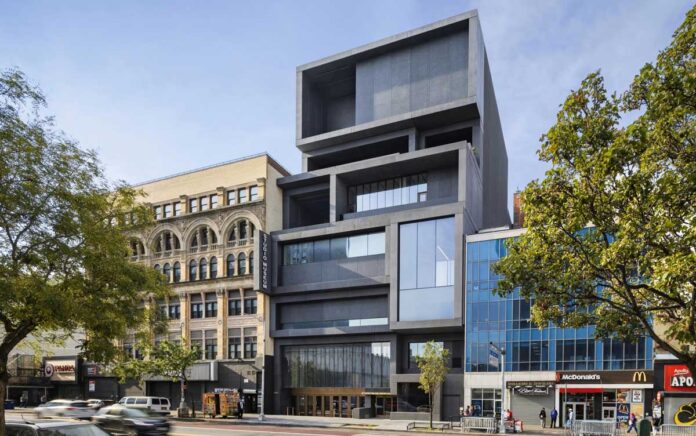Fern Gillespie
When Brooklyn sculptor Helen Evans Ramsaran returned to the Studio Museum in Harlem (SMH) for the unveiling of the new building, she was amazed.
“I was just overwhelmed with the beauty of this space. The flow of space,” the 82 year-old artist told Our Time Press. “Another thing that impresses me too is there are places in that building where you can just go and sit and be quiet. The space in the basement rises up. You have teers like bleachers. It seems that someone very sensitively sat down and said, this is what I would like a new African American museum to be like. I think the whole museum is amazing.”
Ramsaran is an integral part of the Studio Museum in Harlem history. In 1973, after a career as an art professor in the 1960s at HBCU colleges FAMU and Bowie State, she moved to New York to work as the exhibition coordinator at the Studio Museum in Harlem’s first location on Fifth Avenue. Under Ed Spriggs, the director, she worked with the early group legendary master artists like Betye Saar, Benny Andrews, Romare Bearden and Bob Blackburn.
In 1994, her Afrocentric organic bronze sculptures were showcased in her major solo exhibition, “Sanctuary Group,” at the Studio Museum in Harlem. Her bronze sculptures explored African spiritual traditions. The artwork was also featured in the Studio Museum in Harlem’s first Sculpture Garden.
Last year, her exhibition “Strange Fruit” was held at Bed Stuy’s Welancora Gallery. Artnet press championed her work as “UnSung.” She is a part of a small veteran group of Black women sculptors who work with bronze like Babara Chase Riboud and the late Elizabeth Catlett. Located in Crown Heights for 26 years, she creates small and enormous sculptures. “When I went off to Africa, I was impressed with what African people had done with natural forms.
You know, they would take these natural grasses and they could create a whole house with grasses,” she said. Currently, she focusing a major project honoring Black children who have been killed called “Seeds.” “It takes certain conditions for seeds to grow,” she said. “I feel like these children had been put in the position where their potential was about to be realized. Everything been bowed down. I’m working on that series now.”
For Pamela Ford, the Studio Museum in Harlem’s former Director of Education from 1996 to 1999, visiting the new building was “a very different world.” “The building itself is giving you that feeling,” she told Our Time Press. “When I went to the reception for the Studio Museum in Harlem alumni, I found myself standing in the heart of the building and going, wait, what was here before? The structure is so magnificent.
Of course, it’s needed because of the kind of art that necessary to show in really high ceilings. The old building was nice and it was certainly an upgrade from what they originally had on Fifth Avenue. But this is magnificent. And even the little touches like addressing this idea of the public stoops they put in the front. So people could sit so it becomes a community space.”
“The roof deck positions you in Harlem looking down at the rest of downtown from this the wonderful vantage point,” she continued. “It addresses things like a space for programming, a new cafe downstairs, all these things that we envisioned in earlier capital projects in the 1990s.”
Ford, a Brooklyn art consultant and educator and good friend of Ramsaran, still fondly recalls her education work at the museum. “The biggest challenge was getting the local community come in and some of the things that I think we did a good job with was like when I started doing some programming in sculpture garden for free. That was visible from 125th St. and it actually got some people to come in. It was kind of like meeting your neighbor over the garden fence.”
A Studio Museum in Harlem art collaboration that Ford initiated with the Board of Education still exists in Brooklyn. “We established a program for African American and Latin American teenagers to create a mural project that was related to our exhibition about African American artists going to Mexico in the 1930s to work with the Mexican muralists. They were learning techniques like print making and true fresco murals. They created a mural,” she said. “In the last couple of years, I’ve stumbled on it at Paul Robeson High School in Brooklyn. It was the pride of the place in the front.”
Brooklyn is a base for many of America’s top Black artists. These Brooklyn artists are part of the Studio Museum in Harlem’s history — Kehinde Wiley, Kara Walker, Lorna Simpson, Mickalene Thomas, David Hammons, Sonia Louise Davis, Malcolm Peacock, Nari Ward, Sable Elyse Smith, Tschabalala Self, Devin N. Morris, Kevin Beasley, Jeffrey Meris, Charisse Pearlina Weston, Sonia Louise Davis , Zoe Pulley, Hank Willis Thomas. Even Thelma Golden, the Director and Chief Curator at the Studio Museum in Harlem, was a longtime Brooklyn resident.
Currently, Ford is a consultant tour guide for the Brooklyn Museum. For several years, she served as Program Director at the Romare Bearden Foundation and curated the exhibition “From Process to Print: The Graphic Works of Romare Bearden.” The acclaimed exhibit traveled to eight cities including Chicago, Baltimore and Austin.
“I met Bearden as a teenager, when he was doing a film in my neighborhood. He was very kind to myself and my boyfriend. We were both art students in college. So, I felt like it was coming full circle when I got the job at the Bearden Foundation,” she said. “People who knew him, would tell me that Bearden, a co-founder of the Studio Museum in Harlem, was an educator and supporter. That he was concerned. That’s the genesis of the Studio Museum in Harlem. Understanding what Black artists need.”


